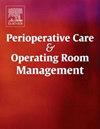右美托咪定和瑞芬太尼用于内镜逆行胆管造影的随机三盲研究
IF 1
Q2 Nursing
Perioperative Care and Operating Room Management
Pub Date : 2025-07-05
DOI:10.1016/j.pcorm.2025.100524
引用次数: 0
摘要
研究了内窥镜逆行胆管造影术中瑞芬太尼和右美托咪定镇静的安全性、有效性和并发症发生率。方法选择行选择性内镜逆行胆管造影的患者72例,随机分为右美托咪定组(右美托咪定组,n = 39)和瑞芬太尼组(雷米组,n = 43)。主要观察指标为并发症发生率和恢复期间的躁动镇静水平。血流动力学变量、不良事件、恶心呕吐状态、异丙酚用量、患者、胃肠病学家和麻醉临床医生满意度评分、镇静水平和出院时间也进行了比较。结果右美托咪定组并发症发生率明显低于瑞芬太尼组(P = 0.0115)。右美托咪定组血氧饱和度明显降低(P = 0.0409)。瑞芬太尼组术后5分钟的RASS平均评分显著高于对照组(P = 0.0054)。在平均动脉压、心率、恶心呕吐状态或患者、胃肠病学家和麻醉临床医生的满意度评分方面,两组间无显著差异(P >;0.05)。出院时间和出院时的搅拌镇静水平无显著差异。结论与瑞芬太尼相比,右美托咪定在内窥镜逆行胆管造影中并发症更少,尤其是氧饱和度更低。此外,在恢复时间和满意度方面没有显著差异,这表明右美托咪定在非手术室麻醉环境中可能优于瑞芬太尼。本文章由计算机程序翻译,如有差异,请以英文原文为准。
Randomized triple-blind study of dexmedetomidine and remifentanil for endoscopic retrograde cholangiopancreatography
Background
The safety profiles, efficacy, and complication rates of remifentanil and dexmedetomidine for sedation during endoscopic retrograde cholangiopancreatography were investigated.
Methods
Eighty-two patients undergoing elective endoscopic retrograde cholangiopancreatography were randomly assigned to the dexmedetomidine group (Group Dex, n = 39) or the remifentanil group (Group Remi, n = 43). The primary outcome was the incidence of complications and agitation-sedation level during recovery. Hemodynamic variables, adverse events, nausea-vomiting status, amount of propofol consumed, patient, gastroenterologist, and anesthetic clinician satisfaction scores, sedation levels, and discharge times were also compared.
Results
The incidence of complications was significantly lower in the dexmedetomidine group compared to the remifentanil group (P = 0.0115). The incidence of oxygen desaturation was significantly lower in the dexmedetomidine group (P = 0.0409). Mean RASS scores at 5 min post-procedure in the recovery unit were significantly higher in the remifentanil group (P = 0.0054). There were no significant differences between the groups regarding mean arterial pressure, heart rate, nausea-vomiting status, or satisfaction scores of patients, gastroenterologists, and anesthesia clinicians (P > 0.05). There were no significant differences in discharge times and agitation-sedation levels at discharge.
Conclusion
Dexmedetomidine was associated with fewer complications, particularly less oxygen desaturation, during endoscopic retrograde cholangiopancreatography compared to remifentanil. Moreover, the absence of a significant difference in recovery times and satisfaction levels suggests that dexmedetomidine may be superior to remifentanil in non-operating room anesthesia settings.
求助全文
通过发布文献求助,成功后即可免费获取论文全文。
去求助
来源期刊

Perioperative Care and Operating Room Management
Nursing-Medical and Surgical Nursing
CiteScore
1.30
自引率
0.00%
发文量
52
审稿时长
56 days
期刊介绍:
The objective of this new online journal is to serve as a multidisciplinary, peer-reviewed source of information related to the administrative, economic, operational, safety, and quality aspects of the ambulatory and in-patient operating room and interventional procedural processes. The journal will provide high-quality information and research findings on operational and system-based approaches to ensure safe, coordinated, and high-value periprocedural care. With the current focus on value in health care it is essential that there is a venue for researchers to publish articles on quality improvement process initiatives, process flow modeling, information management, efficient design, cost improvement, use of novel technologies, and management.
 求助内容:
求助内容: 应助结果提醒方式:
应助结果提醒方式:


